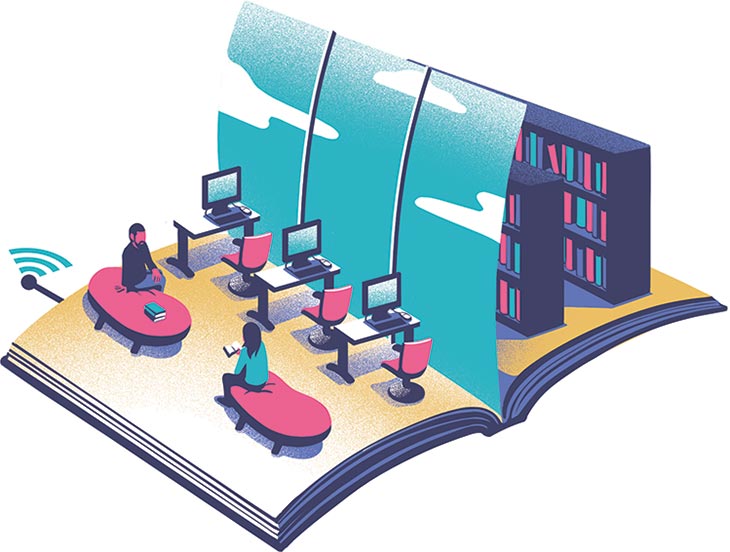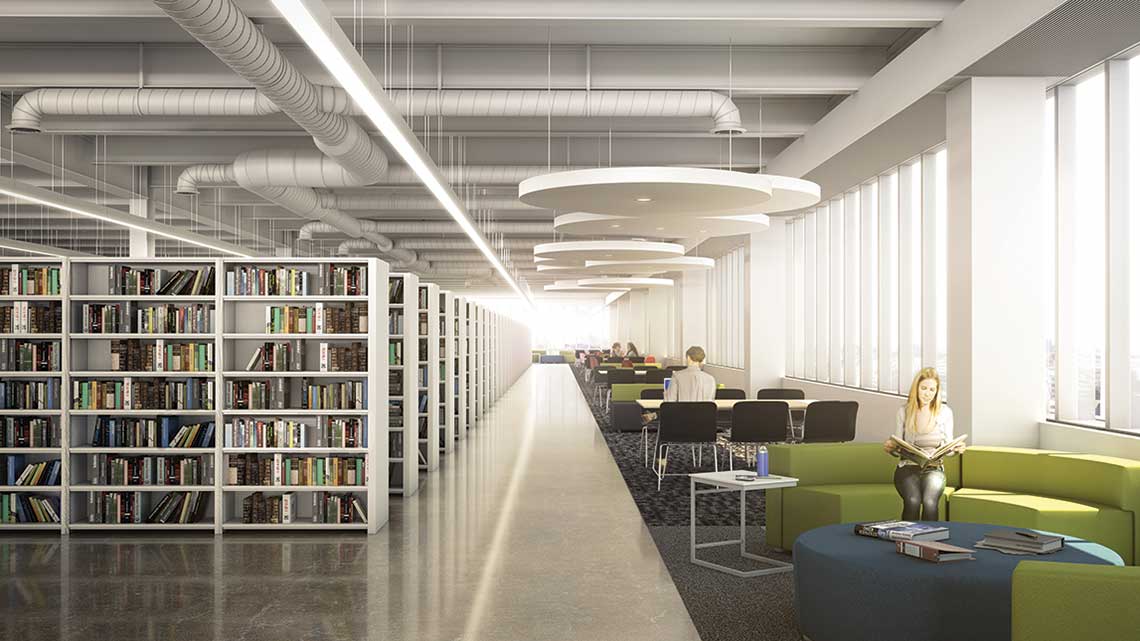THE LIBRARY REIMAGINED
Far from being a staid, static repository of books, the modern library is a sophisticated, high-tech centre of interaction and creativity and a place where users immerse themselves in new forms of information and experience knowledge across disciplines.
Spring/Summer 2017 issue
Carol Shepstone
MRU University Librarian
□
Behind the Shhhhh
It’s happening on campuses throughout North America. University libraries are adapting with agility to new pressures and proving they are more important than ever.
At Mount Royal, the ultramodern Riddell Library and Learning Centre will officially open its doors on Sept. 7.
Transforming a library that was built 40 years ago — when students needed vast print collections and quiet spaces to study alone — has been, “a 10-year revolutionary process,” says University Librarian Carol Shepstone. There have been ongoing efforts to meet the needs of the University despite it having long outgrown the original space.
Change is nothing new though, she says. “Libraries have been evolving forever. There has been no stasis point.”
Named in recognition of a significant donation from the Riddell Family Charitable Foundation to Mount Royal’s Changing the Face of Education fundraising campaign, the building will be an epicentre for research and a highly integrated service provider. A learning space of the future, it will be the intellectual hub of the campus, a central connection point where people, technology and information converge and interact.
“The Riddell Library and Learning Centre is really about ideas and human interaction,” Shepstone says.
The building will give students and faculty room to collaborate and explore, offering access to different forms of knowledge and new types of library resources, from historical artifacts to digital data. The 4,050 square metres of student and collection space the library has today will more than double with its share of the new four-storey, 16,000 square-metre building. Students, faculty and community members will be able to engage with the library’s extensive digital and print collections. They can also use technologies including 3-D scanners and printers, industrial sewing machines, design software, and circuitry and robotics kits to bring words, numbers, pictures and sounds to life on a large scale.
Staff and librarians are learning new skills to support faculty and students’ use of sophisticated components, such as high-tech classrooms, an immersion studio and interactive visualization walls. Users will be able to situate themselves in a virtual reality, say, London in the nineteenth century, Times Square in 1945 or Montreal in the 1970s, and interface with an heirloom from the time, be it sound or music, poetry, a scientific theory or a spreadsheet. Faculty are exploring how best to incorporate these new tools into teaching and learning and how to develop students’ capacities to engage with new forms of information and to critically assess their relevance and value for academic research.
Currently, the library’s holdings include twice as many eBooks as print, and its collection of eJournals outnumbers print journals by about 80 to one. Balancing the collections is a matter of establishing a long-term strategy, says Shepstone.
“There are reasons for print and reasons for digital and times the format doesn’t matter,” Shepstone explains. “What does matter is having a deep understanding of that information environment.
“An undergraduate library like ours collects in a very focused way to meet the specific needs of our degree programs, our students and our faculty.”

□
Bricks, Mortar and Meaning
Like Mount Royal, Toronto’s Ryerson University also recently undertook a major expansion of its library, finishing in 2015. Madeleine Lefebvre, the chief librarian at Ryerson and a former director of library services at Mount Royal says, “The original Ryerson library is a classic example of brutalist architecture when libraries were designed as warehouses for books.”
The new library, in contrast, is a place for “productive collisions” of interdisciplinary skills and projects, she explains, believing that libraries satisfy their higher-learning purpose by integrating their services into the academic mission of a university.
“A library’s role is dictated by what the culture of the campus is doing,” she says, adding that successful libraries across Canada are “embedding themselves” in teaching and learning campus-wide. Smaller university libraries, in particular, can be, “nimble (in) moving with the times,” Lefebvre says.
It is the combination of technical skills and academic strategy that librarians possess that allows them to lead the reimagined library, according to Lefebvre.
Shepstone agrees. “The modern university library is much more than a building. A library can’t do its job without people who do their jobs well.”
Library staff will lead students and visitors to find and critically evaluate all of the digital material now available to them — a much more complex practice today than in the past.
“The information that is being produced has changed,” says Shepstone. There are more input sources and types of data coming together in a modern library, “and what you can do with it all is completely transformed now.”
About the new space
From treadmill desks to cubbies for catnaps, everything a student needs to feel learning-ready will be available at the Riddell Library and Learning Centre. In the MakerStudio, students can use 3-D scanners and printers, industrial sewing machines, design software and circuitry and robotics kits for hands-on learning in support of their research and coursework. Soundproofed project rooms allow users to record, edit and manipulate sound and video to create podcasts, music and media-rich presentations. Visitors can take a break from research or end the day in the café or fireplace lounge. Group-use rooms will increase from three to 34. The number of student stations (or seats) will nearly triple from 650 to 1,800.



The library is also moving its Archives and Special Collections to a safer, climate-controlled area on the fourth floor of the building, which will be more accessible, says Archivist and Special Collections Librarian Peter Houston.
“Eventually, we’ll digitize an array of photos, maps, architectural plans, oral histories and other records for an online database. We want to make it as easy as possible to access the archives’ unique collections, so that they can be an important resource.”
The storage space in the new building is more than 10 times the archives’ current capacity.
“And the new space will also have a large, comfortable reading room, where students can conduct research and where faculty can bring their classes to learn how to search for, evaluate and use archival sources,” Houston says.
History student David Jackson says the increased access to information will be invaluable. “The new archives will be a real improvement over what we currently have. It will be purpose-built and we’ll have much more access to primary research sources than we have now.”
A frequent library user, Jackson looks forward to the move to the new building. “I feel very fortunate that it’s opening while I’m a student here,” he says.
Component parts
With a goal of integrating all of Mount Royal’s services available to support teaching and learning, the new Riddell Library and Learning Centre will incorporate the:
Academic Development Centre (ADC)
A state-of-the-art demonstration classroom, interactive teaching and learning spaces, and the Sandbox drop-in computer lab are among the many aids offered to faculty and teaching staff at the ADC.
Department of Education
The Department of Education will be moving to the Riddell Library and Learning Centre, offering a greater ability for students in the Bachelor of Education — Elementary program to participate in experiential, hands-on learning.
Mokakiiks Centre for Scholarship of Teaching and Learning (Mokakiiks Centre for SoTL)
Mokakiiks Centre for SoTL connects faculty and students from across campus with an international scholarly community to understand and improve teaching and learning in higher education.
Student Learning Services (SLS)
The SLS connects students with peer tutors and mentors working in their field of study, and offers many services and workshops to support student success.
Student Technology and Resource Tutors (START)
The START lab is a place for students wanting dedicated, one-on-one peer help with learning technology.
Archives and special collections
An expanded, environmentally controlled archives and special collections area offers students, faculty and the wider community access to carefully preserved items of historical value.
□
Increased Memory Storage
The library is also moving its Archives and Special Collections to a safer, climate-controlled area on the fourth floor of the building, which will be more accessible, says Archivist and Special Collections Librarian Peter Houston.
“Eventually, we’ll digitize an array of photos, maps, architectural plans, oral histories and other records for an online database. We want to make it as easy as possible to access the archives’ unique collections, so that they can be an important resource.”
The storage space in the new building is more than 10 times the archives’ current capacity.
“And the new space will also have a large, comfortable reading room, where students can conduct research and where faculty can bring their classes to learn how to search for, evaluate and use archival sources,” Houston says.
History student David Jackson says the increased access to information will be invaluable. “The new archives will be a real improvement over what we currently have. It will be purpose-built and we’ll have much more access to primary research sources than we have now.”
A frequent library user, Jackson looks forward to the move to the new building. “I feel very fortunate that it’s opening while I’m a student here,” he says.

□
Intellectual Hub
The Riddell Library and Learning Centre will be the University’s heart of collaboration and discourse, taking into account how students can learn outside of the classroom, interacting with one another and talking through ideas without the constraints that can come with a fear of being graded. Lefebvre says this was instrumental in informing changes at Ryerson’s library, too.
“We wanted to fill in the margins outside of class,” she says, “and focus on the entire university learning experience.”
The facility will bring together many of the crucial elements of the University system. “Our partners in the building are excited about providing integrated services to students and faculty,” Shepstone says. “This is truly everybody’s building. There will be something for everyone, but particularly for students the change is wonderful.”


